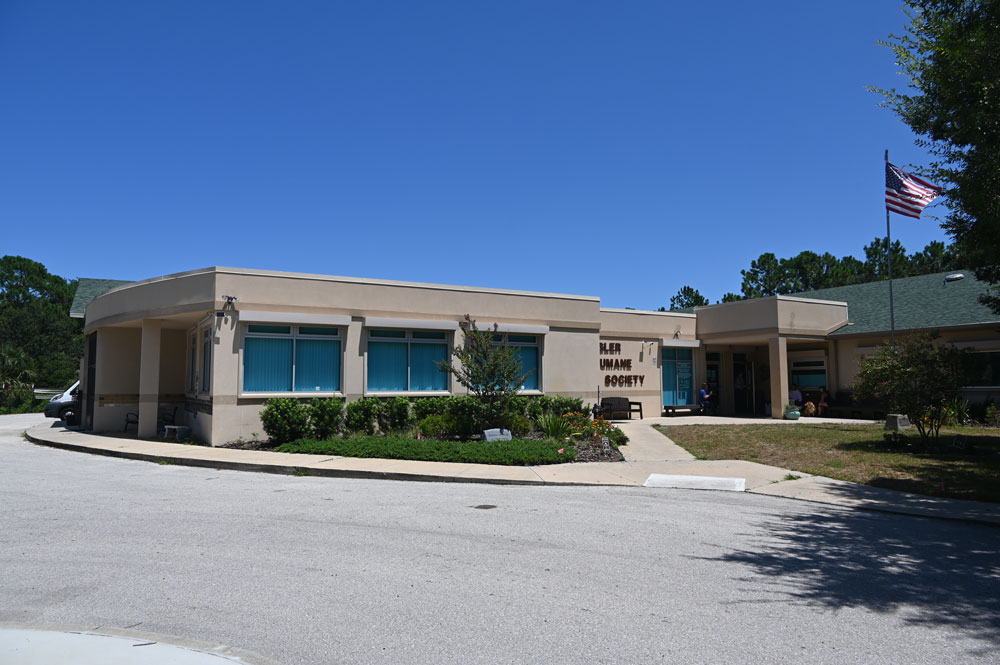
After a year of wrangles with the non-profit and a few pending questions ahead, the Palm Coast City Council has approved its annual contract with the Flagler Humane Society, increasing it to $125,000, from $90,000. But the city is pressing the society to be more forthcoming with its data and future plans for potential expansion.
The contract calls for a fee of $156 per animal that the society handles on behalf of the city, up from $132. It also calls for the delegation of a council member to meet with two society board members and a society staffer once per quarter. The council selected Theresa Pontieri, the vice mayor, who has combined strong criticism and strong advocacy for the society, as she did when the council approved the contract last Tuesday.
Pontieri is not pleased with–as she heard it–the society telling Palm Coast residents who want to surrender an animal to “go home and call our animal control to come then bring the animal in.” She sees that as a “roundabout way to get the fee,” which would not apply if the resident were to surrender the animal without the intervention of the city’s animal control officers.
“We don’t turn people away,” Society Executive Director Amy Carotenuto said. “If somebody is turning their animal in, we usually ask them to make an appointment first, and sometimes they’re not satisfied with that.” An appointment could take 10 days, and the society asks questions: why is the animal being turned in? Can measures be taken to prevent it?
“So they may be the ones to go home and say it’s a stray. We get lied to all the time, but quite the opposite,” Carotenuto said. “We actually would rather have the owners in front of us so that we can talk to them about” the animal’s domesticity. When animal control turns in an animal, the society doesn’t get many details about the animal. The surrender fee is nominal, covering a day’s worth of needs, Carotenut said.
Pontieri favors reducing the time when appointments are granted. Carotenuto pushed back. “It’s a bit of an industry standard now. If anything, we are already kind of shorter,” she said. “If somebody walks in with the animal, and they say they need to surrender it today, they surrender it today.” Pontieri asked for five days. Carotenuto said it was “worth more conversation.”
Pontieri also had questions about the determination of a dangerous dog’s status. The contract leaves it in Palm Coast animal control’s hands to make to determine whether a dog is dangerous–but not whether the dog may be released. But as long as the homeowner meets the requirements of keeping a dangerous dog (the requirements are steep, including the embedding of an electronic chip in the animal, signage at the dog’s house, restrictions on the dog’s freedom), then the dog may be released.
The shelter has struggled with space. But the word “overpopulated” is not defined in the contract. City Attorney Marcus Duffy defined it as when the shelter cannot take in animals. But that has not happened despite crowding. On Oct. 2 the city’s animal control officers turned in 19 animals, and 98 cats in July. So there are times when the shelter is overpopulated, Carotenuto said.
“We make arrangements. I got large walk-in cages that we borrowed from Halifax Humane Society,” Carotenuto said. “So we make do, and then once those animals get adopted, we’re back to normal again. But the animals themselves never suffer because of that. The accusation of–we keep them in crates for months at a time, that’s not the case. The animals that are in crates are waiting for surgery or have just arrived. But the animals themselves aren’t crowded. We might be crowded after the 98 cats. I think I had 16 of them in my office for a while. But they were in the big walk-in cage.”
The implication is that the human beings who work at the shelter may feel more crowded than the animals.
That wasn’t Pontieri’s point, anyway: “I’m asking the question because we’re trying to plan for the future,” she said. “My largest frustration with the Humane Society, shutting out everything that people have said is, I haven’t seen a strategic plan for expansion. That’s my frustration. And I think part of having a strategic plan for expansion is keeping these types of metrics.” But again, Carotenuto had difficulties putting “a hard fast number” on overpopulation.
That lack of measurables greatly bothered Pontieri, who is not interested in fueling criticism of the society, but who wants the society to help itself: “If you don’t have that number to begin with, we don’t know what we need to plan for, we can’t even set money aside to do it and to help you, Amy” Pontieri said. “I’m really trying to get there with everybody and satisfy a lot of concerns here, including being very sensitive to what you all are battling from a public perspective and optics perspective. But I need your help to get this data together.”
By definition, Council member Ty Miller said, any time the society has to organize temporary housing, such as walk-in crates, then the society is overpopulated. The question was not resolved.
The county is considering joining with Palm Coast to run its animal control operation. Palm Coast has its own operation now, but does not have its own animal shelter. So any animal the city picks up must be surrendered to the society. That’s where the per-animal fee comes in. “For animal control, we should have one entity that does it for the whole county,” Council member Dave Sullivan said.





























Dennis C Rthsam says
ADOPT, DONT SHOP!
Ed Danko, former Vice-Mayor, PC says
Your best friend is waiting for you at a shelter! All of my pets have come from shelters, and the truth is the more people I meet, the more I love my pets!
Gail says
We must pull together as a county, the city and the county pool its resources and have one animal control team. Then do what you have been doing. Bring them to the humane society, whose team can take care of the animals with a veterinarian, staff who clean, walk, and care for them. Amy and her team should have a plan in place to enlarge their quarters. That needs to happen soon. Please stop quarreling about it, just get it done. The city and county should be supportive of that, which it now seems they are. I’m hoping!
Jane Gentile Youd says
Amazing staff, albeit the frustration of getting call back over non serious issues such as meds, but they are a wonderful group and dr. Frank is the most amazing Vet we have ever known. He took care of an ugly benign cyst for $150 totALL, on his neck under local anesthesia after 3 other vets said it would cost $1,000 and dog had to go under general. BS Charlie was out in 20 minutes and bouncing like nothing happened and 4 weeks later you can’t even find the stictches. Bravo Theresa, They lost a urine sample; thry misplaced a non mandatory prescription pill for our Heidi but their hearts are there – they just need to get their stuff together as Theresa said. She is a very smart woman.
Pat Stote says
I did not thoroughly read the article however, when we lived in Palm Coast, we had a cat that we had to euthanize which we did at the animal control and later adopted two cats from Flagler humane Society. We always found everything clean and pleasant.
We would stop in when we were out just to go look at the kittens and we were always greeted by Manny. It was just something that we would do to pass the day and look at the beautiful kittens and cats.
We now live in Broward County and I wish we had a place like up there just to stop in and look at the cats and be greeted by someone nice.
Laura says
Have you tried to set up a simple spay/neuter appointment for an adopted kitten? I have and got three times conflicting information. Then I showed up twice to a Saturday shot clinic only to be turned away. First, more than two hours before they closed (sorry no more appointments) and then again because clinic was cancelled that AM (should have checked FB this AM before driving out I was bluntly told by a volunteer? Staff?). Again, this is just to get a wellness appointment and shots for a kitten that will no longer be feral so I can then schedule a spay/neuter appointment (which I’m told are booked out until mid November). I’m also told if my creature is in heat then I’ll be charged more and if I wait too long past the wellness exam to schedule- even though THEY are booked out- I might have to pay to repeat it.
So, I went online & booked an appointment easily online with Halifax Humane in Daytona, driving almost same time as it takes to get across to the Flagler clinic, & had everything done- all shots & microchipped & deed done in the SAME day and for $50+ LESS than Flagler was charging with zero hassle and zero confusion and zero frustration.
If Flagler Humane had clear policies and procedures making it easy for responsible pet owners & transparency & open communication more residents might have different experiences than I have had and thus be less prone to believe some of the, er, “dog pile” happening against the shelter & it’s leadership.
Larry says
County should also pay a per pet fee to the Humane Society when an owner surrenders a pet to the Humane Society, not only pay a fee when the animal is a stray. Humane Society still has to house/feed/medical/adopt out the animal when owner surrenders. Perhaps a slightly reduced fee when owner surrenders versus the fee the county pays for a stray.
Sparks says
Again, they are not transparent. They don’t have room for all the animals, especially with building of all the new homes. We want to know how many dogs and cats you have there? Amy won’t answer.I was told she goes to other shelters to get puppies to adopt. But euthanasia’s other dogs that are there too long. Do you check out Halifax Humane cracking down on them was adopting sick dogs. We need change in Administration! Training would be nice also. Working with the animals, treating training instead of them caged most of the day.
Alexander koufodontis says
This city has no problem raising our water prices to more than double and our taxes every year never listening to its residents that we dont need anymore developments and apartment complexs but has an issue giving an extra 30 grand a year to an organization that helps almost every pet owner in town ive lived here my whole life and im really starting to hatr it here